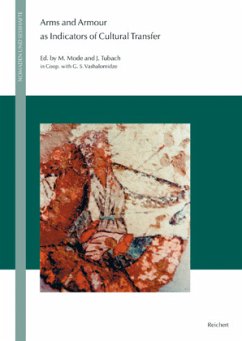The contributions in this volume give an impression of contemporary archaeological, art historical, and historical research in military equipment of and under the influence of nomadic peoples in Eurasian history. The studies cover a considerably long time span and a broad territory: from the Iron Age up to the Middle Ages, and from Central Europe to the heartlands of China.
Aside from strategical and tactical points of view, reasons for nomadic successes in warfare can obviously be seen in their equipment, the systems of weaponry, armour and accessories. These questions about nomadic military equipment are questions for the archaeologist. Analyzing and reconstructing forms, establishing typological sequences, comparing enhancements with shortcomings of arms and armour, the archaeologist is in the position to supplement facts to written history of campaigns and the reasons for successful or lost wars. But of course, this special field of contemporary archaeology should not be merely defined as a "military archaeology". Arms and armour have to be explained within their archaeological context; that is, as parts of a complex system of remains from past societies. And seen from this perspective, they also explain, beyond their primary character as military sources, the broader sphere of life of nomadic peoples, their efforts in technology and in art, and key aspects of their spiritual world.
One special value of arms and armour as an archaeological and art-historical source is its potential to indicate the sharing of knowledge, of technology, but also of experience in a broader sense among completely different cultures. For this reason, the articles in this volume are well established within the framework of the Collaborative Research Centre "Difference and Integration".
Aside from strategical and tactical points of view, reasons for nomadic successes in warfare can obviously be seen in their equipment, the systems of weaponry, armour and accessories. These questions about nomadic military equipment are questions for the archaeologist. Analyzing and reconstructing forms, establishing typological sequences, comparing enhancements with shortcomings of arms and armour, the archaeologist is in the position to supplement facts to written history of campaigns and the reasons for successful or lost wars. But of course, this special field of contemporary archaeology should not be merely defined as a "military archaeology". Arms and armour have to be explained within their archaeological context; that is, as parts of a complex system of remains from past societies. And seen from this perspective, they also explain, beyond their primary character as military sources, the broader sphere of life of nomadic peoples, their efforts in technology and in art, and key aspects of their spiritual world.
One special value of arms and armour as an archaeological and art-historical source is its potential to indicate the sharing of knowledge, of technology, but also of experience in a broader sense among completely different cultures. For this reason, the articles in this volume are well established within the framework of the Collaborative Research Centre "Difference and Integration".
"Der Band fasst die Vorträge eines in Wittenberg 2003 abgehaltenen Symposiums in schriftlicher Form zusammen. Er gibt damit einen Überblick über den Forschungsstand sowie von archäologischen und historischen Erkenntnissen anhand der militärischen Ausrüstung der eurasischen Steppenvölker. Inhaltlich erstreckt sich das Thema über einen weiten chronologischen wie geographischen Horizont von der Eisenzeit bis zum Mittelalter, von Mitteleuropa bis ins chinesische Herzland.
Neben strategischen und taktischen Aspekten lassen sich die Erfolge der nomadischen Kriegsführung an ihrer Ausrüstung, an ihrer Bewaffnung, Rüstung und Zubehör ablesen. Aber selbst diese Erkenntnisse werden von den Archäologen hinterfragt. Durch Analyse und Rekonstruktion der Artefakte werden typologische Reihen formiert und durch Betrachtung ihrer Stärken und Schwächen auch ergänzende Erkenntnisse in die Analyse eingebracht. In Verbindung mit den Schriftquellen lassen sich so die Gründe für erfolgreiche oder verlorene Kriege rekonstruieren.
Dabei kann sich die Archäologie nicht allein als Militärarchäologie verstehen, denn Waffen und Rüstung sind in ihrem archäologischen Zusammenhang zu sehen, als Teile einer komplexen vergangenen Gesellschaft. Sie erklären dadurch auch eine breitere Sphäre des nomadischen Lebens, das die Anstrengungen in Technologie und Kunst spiegelt und damit Einblicke in die spirituelle Welt dieser Wandervölker ermöglicht."
In: Pallasch. Heft 26 (2008). S. 297.
Neben strategischen und taktischen Aspekten lassen sich die Erfolge der nomadischen Kriegsführung an ihrer Ausrüstung, an ihrer Bewaffnung, Rüstung und Zubehör ablesen. Aber selbst diese Erkenntnisse werden von den Archäologen hinterfragt. Durch Analyse und Rekonstruktion der Artefakte werden typologische Reihen formiert und durch Betrachtung ihrer Stärken und Schwächen auch ergänzende Erkenntnisse in die Analyse eingebracht. In Verbindung mit den Schriftquellen lassen sich so die Gründe für erfolgreiche oder verlorene Kriege rekonstruieren.
Dabei kann sich die Archäologie nicht allein als Militärarchäologie verstehen, denn Waffen und Rüstung sind in ihrem archäologischen Zusammenhang zu sehen, als Teile einer komplexen vergangenen Gesellschaft. Sie erklären dadurch auch eine breitere Sphäre des nomadischen Lebens, das die Anstrengungen in Technologie und Kunst spiegelt und damit Einblicke in die spirituelle Welt dieser Wandervölker ermöglicht."
In: Pallasch. Heft 26 (2008). S. 297.

